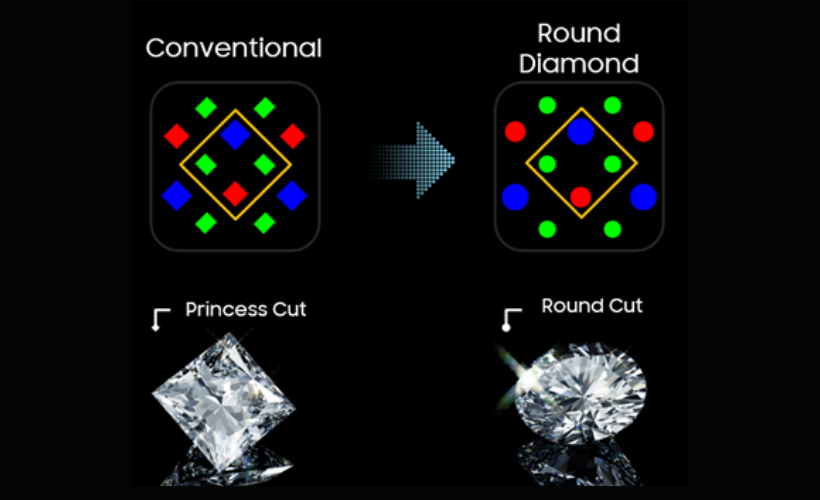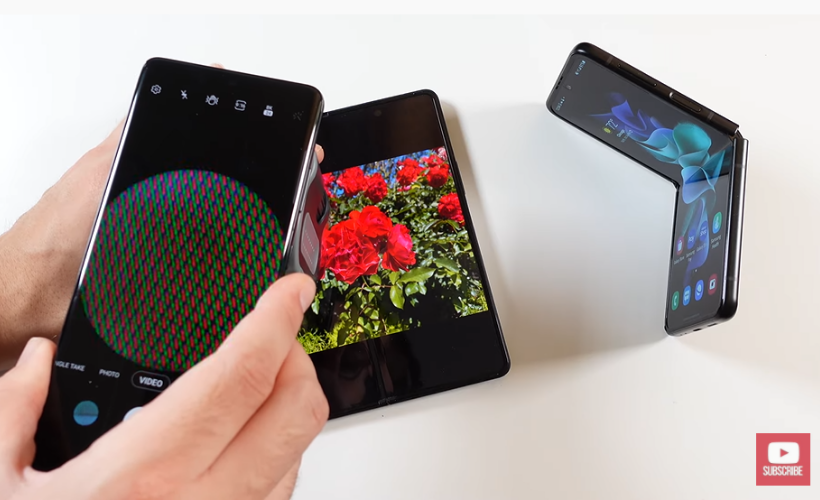On average, we pick up our phones 58 times a day (the Guardian). Every time you look at your smartphone screen, have you ever wondered what it might look like under a microscope and why Samsung continues to innovate display technology on a sub-pixel level? If you haven’t heard about Diamond Pixel™ yet, here’s why it makes your smartphones even more exceptional:
What is a Diamond Pixel?™
About 99 percent of our body is made up of atoms of hydrogen, carbon, nitrogen, and oxygen. Diamond Pixel™ is the atoms of Samsung’s OLED displays, consisting of red, blue, and green (RGB) screen dots in the shape of diamonds. Just like our bodies, displays depend on these sub-pixels to sense and represent visuals. Every image, every word you see on your smartphone screen is an accumulation of these tiny dots.
Diamond Pixel structure was first introduced by Samsung Display in 2013 on OLED panels of the Galaxy S4 series. Since then, Diamond Pixel™ became the standard structure on all Samsung OLED.

How is it Different from Other Pixel Design?
Aim of display technology is to be as close to real life as possible, and recreating life-like visuals depends on human perception of colors. So what if we mimic our human eye to create the best display possible? That’s what Samsung is trying to achieve with Diamond Pixel™: It is a form of biomimicry* inspired by the natural system of our human body and designed to perfect our digital realms.
*An approach that solves human challenges based on innovations emulating patterns and systems found in nature
Not only does it structurally resemble the human eye, it is designed by considering color sensitivity. For example, the human eye sees green better than any color in the spectrum, which explains why the green screen dots are smaller and densely populated in Diamond Pixel™. In a nutshell, pixel structures of three primary colors are designed in consideration of the characteristics of each RGB color material.
Why is Diamond PixelTM Better for Users?
Diamond Pixel™ is more than just beautiful aesthetics. After all, what users find most impressive about displays is clarity/readability of the image displayed, and this depends on the pixel density.
Simply put, users want high resolution, which means a display with high density of pixels (number of pixels per inch). The more pixels we can closely pack in, the better. In order to achieve the highest resolution or pixels per inch (PPI), Samsung Display succeeded in designing the most optimal spatial frequency design with a 45 degree diagonal symmetry across the entire display layout. This strategic placement results in twice as many green pixels as blue and red ones, and as previously mentioned, green is the most visible color.
These days smartphones are used in a variety of fields from texting to watching videos, gaming, and taking pictures - depending on the users’ needs, displays should be able to express crisp, dynamic images. For example, it needs to show complex patterns when representing characters while displaying straight and thin diagonal lines for line expressions.
With a packed concentration of highly visible green pixels, Samsung Display’s Diamond Pixel™ is more legible than any other pixel structure available in the market: They are exceptional in expressing sharp, fine patterns such as straight and diagonal lines. Therefore, no matter the content on the screen, it can show the most accurate and clear images. You’ll notice this crispness especially on the edges of the Diamond Pixel™.
What is the Round Diamond Pixel™?

Last August, Samsung Display introduced Eco² OLED™ technology on the Galaxy Z Fold3 smartphones. The Eco2 OLED™ eliminates the need for a polarizer layer, an opaque plastic sheet typically attached to displays to prevent the panel from reflecting external light. Without a polarizer layer, the display has 33 percent more transmittance which reduces power consumption by 25% compared to conventional OLED panels.
Removing the polarizer layer was quite a revolutionary change, and this new technology required pixel structure optimization to ensure better light transmittance. That is why Samsung Display released the Round Diamond Pixel™, illuminating light flawlessly with rounded red, blue, and green pixel points. Even though the pixel arrangement and resolution are the same as the iconic Diamond Pixel™ arrangement, Round Diamond Pixel™ for Eco² OLED™ displays can now make smartphone users enjoy brighter screens with less power consumption. In fact, as the first and only smartphone to feature this technology, Samsung Galaxy Z Fold3 shows bright and vivid color in the smartphone market today.
Conclusion

Award-winning smartphones featuring Samsung OLED include: The Galaxy S21 Ultra winning the ‘Best Smartphone’ of MWC 2021 and Galaxy Z Flip3 being named as TIME’s Best Inventions of 2021 for making mainstream phones with foldable display. The Galaxy S20 Ultra was also recognized as the most color accurate screen Display mate has ever tested, earning an A+ grade in 2020.
Samsung Display commits to not only improving picture quality but also developing new pixel designs that are optimal for upcoming technologies. In addition to the Diamond Pixel™, the new Round Diamond Pixel™ is a reminder that the continuous evolution of Samsung Display’s display technology and persistence to upgrade industry standards will empower people both online and offline.




